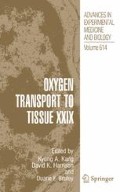Abstract
Lactate has been reconsidered! As we now know, most is produced aerobically We report that lactate accumulation commonly occurs in the presence of oxygen and is sufficient to instigate signals for angiogenesis and connective tissue deposition. These include vascular endothelial growth factor (VEGF), transforming growth factor beta (TGF beta), interleukin-1 (IL-1), and hypoxia-inducible factor (hif-1alpha). This paper, a mini-review, is occasioned by new data showing increased presence of VEGF and angiogenesis in an oxygenated site by adding a slow-release source of lactate into Matrigel® and implanting the Matrigel subcutaneously in mice.
Access this chapter
Tax calculation will be finalised at checkout
Purchases are for personal use only
Preview
Unable to display preview. Download preview PDF.
References
Q. P. Ghani, S. Wagner, H. D. Becker, T. K. Hunt, M. Z. Hussain. Regulatory role of lactate in wound repair. Methods Enzymol. 2004; 381:565–75.
J. S. Constant, J. J. Feng, D. D. Zabel, H. Yuan, D. Y. Suh, H. Scheuenstuhl, T. K. Hunt, M. Z. Hussain. Lactate elicits vascular endothelial growth factor from macrophages: a possible alternative to hypoxia. Wound Repair Regen. 2000 Sep–Oct; 8(5):353–60.
S. Beckert, F. Farrahi, R. S. Aslam, H. Scheuenstuhl, A. Konigsrainer, M. Z. Hussain, T. K. Hunt. Lactate stimulates endothelial cell migration. Wound Repair Regen. 2006 May–Jun; 14(3):321–4.
B. Formby, R. Stern. Lactate-sensitive response elements in genes involved in hyaluronan catabolism. Biochem Biophys Res Commun. 2003 May 23; 305(1):203–8.
L. B. Gladden. Lactate metabolism: a new paradigm for the third millennium. J Physiol. 2004 Jul 1; 558(Pt 1):5–30. Review.
J. E. Albina, B. Mastrofrancesco, J. A. Vessella, C. A. Louis, W. L. Henry, Jr., J. S. Reichner. HIF-1 expression in healing wounds: HIF-1alpha induction in primary inflammatory cells by TNF-alpha. Am J Cell Physiology. 2001 Dec; 281(6):C1971–7.
S. Biswas, M. Ray, S. Misra, D. P. Dutta, S. Ray. Is absence of pyruvate dehydrogenase complex in mitochondria a possible explanation of significant aerobic glycolysis by normal human leukocytes? FEBS Lett. 1998 Apr 3; 425(3):411–4.
O. Trabold, W. Wagner, C. Wicke, H. Scheuenstuhl, M. Z. Hussain, N. Rosen, A. Seremetiev, H. D. Becker, T. K. Hunt. Lactate and oxygen constitute a fundamental regulatory mechanism in wound healing. Wound Repair Regen. 2003 Nov–Dec;11(6):504–9.
Q. Liu, U. Berchner-Pfannschmidt, U. Moller, M. Brecht, C. Wotzlaw, H. Acker, K. Jungermann, T. A. Kietzmann. Fenton reaction at the endoplasmic reticulum is involved in the redox control of hypoxia-inducible gene expression. Proc Natl Acad Sci U S A. 2004 Mar 23;101(12):4302–7.
H. W. Hopf, J. J. Gibson, A. P. Angeles, J. S. Constant, J.J. Feng, M. D. Rollins, M. Z. Hussain, T. K. Hunt. Hyperoxia and angiogenesis. Wound Repair Regen. 2005 Nov–Dec;13(6):558–64.
A. Y. Sheikh, J. J. Gibson, M. D. Rollins, H. W. Hopf, Z. Hussain, T. K. Hunt. Effect of hyperoxia on vascular endothelial growth factor levels in a wound model. Arch Surg. 2000 Nov; 135(11):1293–7
M.A. Ali, F. Yasui, S. Matsugo, T. Konishi. The lactate-dependent enhancement of hydroxyl radical generation by the Fenton reaction. Free Radic Res. 2000 May;32(5):429–38.
H. Lu, C. L. Dalgard, A. Mohyeldin, T. McFate, A. S. Tait, A. Verma. Reversible inactivation of HIF-1 prolyl hydroxylases allows cell metabolism to control basal HIF-1. J Biol Chem. 2005 Dec 23;280(51):41928–39.
C. K. Sen, S. Khanna, B. M. Babior, T. K. Hunt, E. C. Ellison, S. Roy. Oxidant-induced vascular endothelial growth factor expression in human keratinocytes and cutaneous wound healing. J Biol Chem. 2002 Sep 6;277(36):33284–90.
D. D. Zabel, J. J. Feng, H. Scheuenstuhl, T. K. Hunt, M. Z. Hussain. Lactate stimulation of macrophage-derived angiogenic activity is associated with inhibition of Poly (ADP-ribose) synthesis. Lab Invest. 1996; 74:644–9.
Author information
Authors and Affiliations
Editor information
Editors and Affiliations
Rights and permissions
Copyright information
© 2008 Springer Science+Business Media, LLC
About this paper
Cite this paper
Hunt, T.K., Aslam, R., Hussain, Z., Beckert, S. (2008). Lactate, with Oxygen, Incites Angiogenesis. In: Kang, K.A., Harrison, D.K., Bruley, D.F. (eds) Oxygen Transport to Tissue XXIX. Advances In Experimental Medicine And Biology, vol 614. Springer, Boston, MA. https://doi.org/10.1007/978-0-387-74911-2_9
Download citation
DOI: https://doi.org/10.1007/978-0-387-74911-2_9
Publisher Name: Springer, Boston, MA
Print ISBN: 978-0-387-74910-5
Online ISBN: 978-0-387-74911-2
eBook Packages: Biomedical and Life SciencesBiomedical and Life Sciences (R0)

